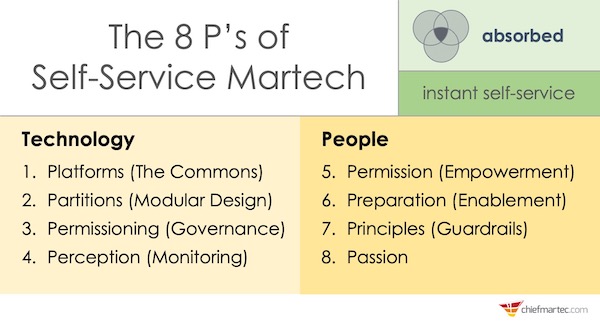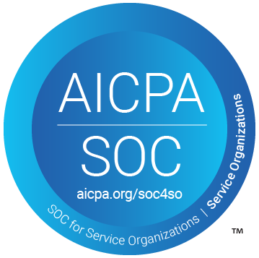Scott Brinker is a leading martech industry expert. He is the creator of the annual Marketing Technology Landscape supergraphic, editor of ChiefMartec.com and also serves as the VP Platform Ecosystem for HubSpot. When it comes to marketing technology platforms, it’s safe to say that Scott not only knows his stuff, he has served as a driving force of the martech industry since its conception.
In late 2019, Scott published the “8 P’s of Self-Service Martech,” a fascinating martech model that includes eight necessary components of an “absorbed” martech maturity stage. These eight components are an equal mix of technology factors (platforms, partitions, permissioning and perception) and people factors (permission, preparation, principles and passion).
In his original post covering the “8 P’s of Self-Service Martech,” Scott emphasized that the key to reaching an absorbed level is the adoption of self-service martech-related tools that can be used by marketers outside of the core marketing operations team. This concept immediately resonated with stensul. Since our launch, we’ve focused our efforts on building a no-code agile email creation platform that democratizes the email creation process, making it accessible to people across business units and all levels of technology skills.

As self-service martech evangelists, we wanted to dive even deeper into Scott’s martech maturity model. Lucky for us, he was open to spending some time talking with our CEO Noah Dinkin and allowing us to share their conversation with marketing operations leaders looking to create more agile email creation processes.
A Conversation with Scott Brinker
Noah Dinkin: Businesses are facing an increasing number of challenges when it comes to reaching program maturity — the stage in which a program is able to improve issues and fix errors quickly and seamlessly, without disrupting production or workflow. For some marketers, this falls under part of the ‘low code/no code’ movement.
There’s the technical complexity of email coding which often introduces plenty of rendering issues, which is a major pain for everybody involved in creating emails. You have to translate permissions and guardrails through very expensive experts who have limited capacity.
If you want to double the amount of work you are performing, you likely need to double the amount of people on your team which can be too much of a financial burden for plenty of companies. It’s a weird combination of things to solve for: How do we decentralize or distribute that and scale with technology throughout the organization?
Scott Brinker: By far, the number one thing is cultural management practice. Most of these companies have been in a mode where, for a long time, they’ve had strict control over who’s actually doing things. This sort of decentralization faces cultural legacy and barriers that are embedded in people’s subconscious. It’s not like they’re even fundamentally saying, ‘Oh, no, no, we could never do that.’ They just don’t necessarily think of it.
The governance is super important. There is very little governance control when anyone can integrate anything. It ends up creating more problems sometimes than it solves. And so striking that balance of self-service flexibility with some governance control in a way that is helpful to people is key.
The fine balance between Governance and Self-Service Technology
Noah Dinkin: Which kinds of governance should be handled by technology?
Scott Brinker: There’s a proactive versus a reactive split to it. On one hand, there’s setting certain rules in actual technical implementation or just in policy. But part of the challenge is that some of those things become so open-ended that you can’t legislate all of it in advance.
It also becomes more of a reactive governance monitoring capability, to be able to assess what’s happening as issues come up. When anomalies or other new use cases start to emerge in the ecosystem, you need the ability to quickly detect those and make sure people don’t get overwhelmed.
A lot of that stuff lends itself to rules. Things still seem like they’re really stuck on the human side when it comes to the content itself. You can use workflow rules to help get the right approvers and the right reviewers. But for a lot of companies, there still is that human component. If you’re going to make a certain offer, you want that review process to be as streamlined as possible.
Noah Dinkin: What are some pitfalls marketers can fall into? Like getting too comfortable with the newfound power that low and no code platforms allow them?
Scott Brinker: People need to think structurally like an engineer would, even if they’re not writing the actual code. Marketers can put automations in place, but when it goes live people lose track of whether it’s even running or what it’s doing.
Noah Dinkin: Not ideal.
Scott Brinker: No, certainly not.
The Rise of the Marketing Technologist
Noah Dinkin: With all of these technological advancements and constantly shifting roles within marketing and platform creation, how are marketers becoming increasingly self-service oriented?
Scott Brinker: It used to be that anything you wanted to do with software really had to be run by the IT department. And then, in the marketing world, we saw the rise of the marketing technologist. This person essentially runs the marketing ops, or the marketing tech stack.
I think of marketing technologists as domain experts, because they’re still experts in systems management and software development, but they’re very much focused on the domain of marketing. They really understand it in context. In fact, their marketing depth probably exceeds their software and systems depth. They’re not necessarily as technical as a counterpart in IT might have been — I think of them really as the power users.
That’s largely where we are today with most of this stuff — it’s either the professional marketing ops people or the power users who are driving a lot of martech usage. But the technology makes it so friendly for a non-power user to go in and create an email. Anyone can do it.
In the next five years, the average marketer is going to be able to do things that before would have been designated for PhD experts.
Noah Dinkin: That’s the point of technology like stensul’s: To make everyone’s job easier and more efficient. Let’s be honest, no one likes coding emails. A team might create every email from scratch — which is a terrible idea, but happens often. The initial challenge of coding the email is hard enough and it’s even more difficult if a creator needs minor edits like bolded text or a new image size. The mind-numbing rote production of these asks will drive even the most dedicated designers up the wall.
Marketing Ops: The champions of self-service martech enablement
Noah Dinkin: Where is this technological change coming from? The CMOs?
Scott Brinker: The decentralization is happening more from the bottom up. Everyone has a set of goals and KPIs and ideas of how to do it. So they’re going to find whatever way they need to be able to make that happen. People are very creative.
Remote work, which clearly saw a boost this year, is going to be another factor that makes it more culturally acceptable to think of decentralization. It’s just harder to have all the meetings in a process that’s so traditionally centralized.
The people who are running marketing ops will become very big champions of decentralization once it’s clear to them that it is a problem and one they can actually help solve with the implementation of a certain kind of technology — and that they can demonstrate the return and the impact on it.
Noah Dinkin: What will come next in this wave of technological marketing advances?
Scott Brinker: I don’t see how we do anything other than continue as an industry to move more towards the absorbed model, primarily because of the sheer volume and competitive dynamics. The moment your competitors start eliminating these bottlenecks — so that their bandwidth to be able to experiment and run effective campaigns just gets exponentially greater than yours — you’ll need to do the same.
If companies haven’t already, they’ll soon realize that there’s no need to spend thousands of dollars or weeks on an email that they can create in minutes with stensul. As low/no code platforms and decentralization become the new marketing normal, companies will have to jump on board to keep up, or risk falling severely behind.
Noah Dinkin: I completely agree. Low and no code platforms are so important. The benefits they provide really underscore the power of stensul’s email creation platform. Scott, I can’t thank you enough for taking the time to talk today. It’s always so enlightening to hear your perspective on the martech industry.





